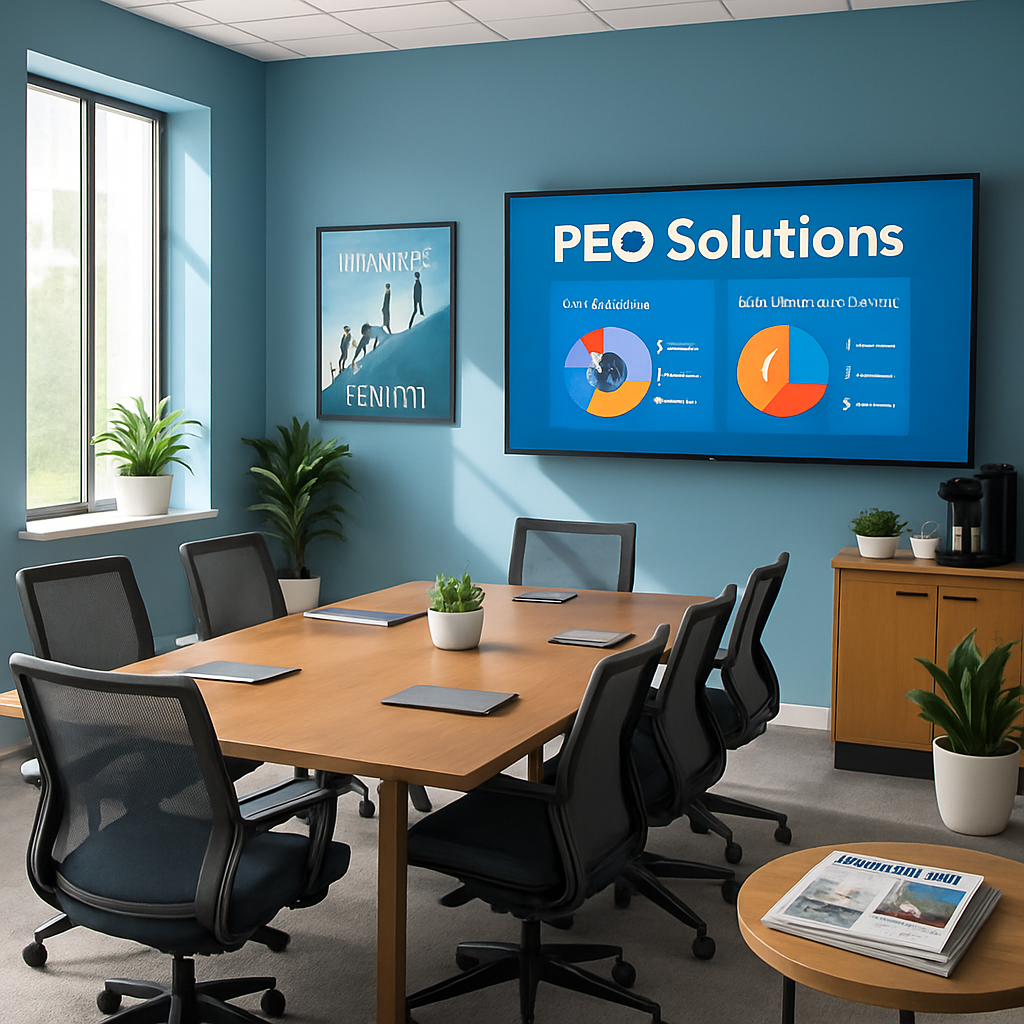- Home /
- The EaseBlog /
- PEO
The EaseBlog: PEO

PEO Pros and Cons for Employers and Employees
Professional employer organizations (PEOs) have exploded in popularity over the last decade, with over 487 currently operating in the US. But what exactly are PEOs, and are they the right secret sauce for your business?
At their core, PEOs are built on a model called co-employment. Once partnered, they become the official "Employer of Record" and manage critical Human Resources (HR) responsibilities like payroll, benefits, and compliance.
Importantly, co-employment does not mean a loss of control over day-to-day decision-making, such as hiring and firing.
You maintain authority over your staff and business operations. The professional employer organization simply files payroll taxes under their Federal Employer Identification Number (FEIN) as a service while you continue directing your team day-to-day. This enables PEOs to file federal and state employment taxes for you, something that no payroll provider is able to offer.
By tapping into the economies of scale from pooling together employees from multiple client companies, a PEO can offer enhanced HR capabilities and cost efficiencies typically out of reach for small and mid-sized businesses. However, they also come with drawbacks and aren't a fit for every organization.
First, we'll examine the potential upsides and downsides from an employer's point of view. The benefits of PEOs for companies are wide-ranging, but intelligent leaders also carefully weigh the risks.
What do employers consider the pros of using a PEO?
The potential upsides are plentiful when weighing the pros and cons of using a PEO from an employer perspective.
First and foremost, partnering with a PEO provides instant access to high-level HR expertise without requiring companies to build an extensive in-house HR team. They come equipped with specialized professionals to handle vital functions like recruitment, training, health benefits, HR compliance, payroll processing, and state unemployment claims administration.
This enables organizations to focus their limited time and resources on core business priorities rather than getting bogged down in "people" issues. Seasoned HR experts handle the administrative lift.
PEOs also deliver considerable cost savings by leveraging economies of scale. Through pooling together worksite employees from multiple client companies, they can negotiate discounted rates on insurance policies, HR systems, and other programs that would be more expensive for an individual small business to purchase alone. These cost efficiencies make it feasible for even 10 or 15-person companies to offer Fortune 500-caliber benefits packages that attract and retain top talent.
Employees notice and appreciate expanded benefits.
Additionally, PEOs substantially reduce HR-related risks and handle myriad compliance hassles, providing invaluable peace of mind. Business owners don't want to stress about whether an employee handbook meets complex regulatory requirements or if one wrong hire opens the business to liability.
PEOs assume these risks and responsibilities, allowing leadership to feel confident that the "people" side is fully covered.
Other upsides include the scalability offered as business needs change. Adding or removing staff is seamless with the PEO's systems and infrastructure supporting workforce adjustments.
While those paint an optimistic picture, prudent employers also weigh the other side of the scale. We'll explore those next before turning to employee perspectives.
What do employers consider the cons of using a PEO?
Engaging a PEO does entail relinquishing some control over some HR decisions and customization abilities. They deliver economies of scale in part by offering standardized bundles of services and more limited configuration options compared to handling HR entirely in-house. However, as mentioned, you retain all day-to-day decision-making abilities.
Transitioning to a PEO partnership also inevitably involves some growing pains. It takes time to fully integrate the PEO's systems, train managers on new protocols, and smooth out any problems. Realistically anticipating the required transition effort is vital.
Cost is another consideration. While PEO services provide significant cost efficiencies in many areas, their ongoing service fees could potentially exceed the cost of having internal HR staff for some organizations if not analyzed closely.
These aspects require careful evaluation. Next, we'll switch gears to examining impacts on employees.
What are the advantages of a PEO for employees?
When evaluating a PEO’s impact on employees, the positives are plentiful according to research by the National Association of Professional Employer Organizations (NAPEO).
Employees at PEO client firms enjoy meaningful improvements in benefits offerings, gaining access to enhanced health insurance, retirement plans, wellness programs, and other perks. For many employees, these improved benefits deliver a significant boost in satisfaction. Knowing their families are covered gives them peace of mind. This is accompanied by exhaustive benefits administration.
Professional employer organizations also provide expanded training and development opportunities through their extensive online libraries and resources. Employees at all levels can self-direct their learning to gain new skills rather than waiting for limited local workshops.
With HR professionals efficiently handling common HR administrative tasks like payroll, compliance, and recruiting, employees feel their pressing needs and issues get resolved faster. Employees have praised the increased bandwidth of internal managers to focus on strategic HR initiatives when routine, time-consuming tasks shift to the PEO.
A NAPEO study from 2017 revealed that employees give higher marks to the overall work culture and environment at PEO client firms, citing improved hiring practices and job design in particular. Clearly defined roles, expectations, and streamlined processes empower employees to succeed.
Improved metrics on engagement, job security, intent to stay long-term, and confidence in leadership all underscore the positives PEOs can bring to corporate culture. Employees believe management is freed up to focus on growth and steer the company to greater success, with the PEO providing "people" support.
What are the disadvantages of a PEO for employees?
Change inherently brings some disruption, and implementing new PEO systems and processes requires training and an adjustment period. Employees need time to get accustomed to new HR platforms and contacts. Streamlining training and communication helps smooth transitions.
With the PEO controlling many programs and policies, employees may feel they have less direct input into shaping benefits or initiatives based on their preferences. However, good PEOs seek regular feedback to refine offerings.
Employees interacting with external PEO staff versus internal HR contacts may feel more disconnected. Strong internal branding and communication help maintain cultural ties.
There is also some unavoidable instability during transitions as the handoff to the PEO ramps up. Manager training and boosted employee communication are crucial to minimizing hiccups. Celebrating quick wins helps the change take root.
While these potential hurdles deserve consideration, the wide-ranging upsides suggest that most can be managed carefully. Now, let's examine critical factors for a seamless PEO implementation.
How can Employers Get Employees Onboard with a PEO?
A smooth employee transition is crucial when adopting a PEO partnership. Several best practices help get staff onboard and minimize disruption:
- Clearly communicate the specific benefits the PEO will enable, like enriched health insurance, retirement plans, workers' compensation insurance, training programs, and other perks employees value. Don't just announce the PEO decision; explain the meaningful improvements it will bring. Employees crave context on how the change is good for them.
- Involve staff in the PEO vendor selection process by seeking input on needs and preferences during the vetting stage. This makes employees feel heard and builds greater buy-in once the PEO is selected. No one likes decisions imposed top-down without a voice.
- Invest time upfront in thoroughly training managers to address questions and concerns openly once the PEO rollout begins. Equip leadership to convey what is changing and their excitement about improvements the PEO will fuel. This shapes consistent frontline messaging.
- Frequently highlight how the PEO will enhance, not distract from, corporate culture by freeing up internal bandwidth previously consumed by administrative burdens. The goal is to elevate the employee experience, not outsource it.
- Stress how the PEO partnership enhances support, unlocks exciting development opportunities, and ensures job security by powering growth. Employees want reassurance amidst change. Reinforcing "what's in it for them" eases concerns and builds adoption.
With robust communication, involvement, training, and reinforcement, companies can minimize PEO partnership disruption and speed time to value.
Is a PEO the right fit for your business?
When weighing the advantages and disadvantages of using a PEO, you would be justified in having both optimism and caution. On the one hand, the potential benefits are tremendous - access to expertise, improved benefits, risk reduction, data-driven insights, and more. However, the disadvantages are also real - change management challenges, culture considerations, and unknown risks.
Ultimately, determining if relinquishing some HR autonomy is the right strategic move requires scrutinizing your specific business context and needs:
What are your current pain points around HR?
Are you struggling to find the bandwidth internally to deliver the recruiting, development programs, compliance management and other support your growth plans require?
Does the lack of HR capabilities feel like a bottleneck?
Can you invest the time and resources required to properly transition to the PEO? Rushing implementation creates pitfalls.
What does a phased adoption timeline look like?
Analyzing factors like these will clarify whether the pros outweigh the cons for your organization. Every business context is unique. Thorough diligence on all dimensions allows you to make the wisest decision for your goals.
If you aren't sure what your HR pain points are, you can find out for free by taking Easeworks' HR Risk Assessment. The average company score is 60.
What's yours?
Blog Categories
- PEO (21)
- Employees & Culture (13)
- Risk Management (8)
- HR Outsourcing (7)
- Human Resources (6)
- Workers' Comp (6)
- Compliance (5)
- Payroll (5)
- PAGA (4)
- Benefits (3)
- Flexible Spending Account (3)
- Podcasts (3)
- Diversity (2)
- HR technology (2)
- Training (2)
- ASO (1)
- Healthcare Savings Account (1)
- Inclusion (1)
- Legal Updates (1)
- PTO (1)
- SB 553 (1)
- Special Districts (1)
- recruiters (1)
- staffing (1)
Subscribe Here!
Let us help streamline the way you manage HR.

Subscribe for our the latest news and legal updates that will affect your business.
Newsletter Sign Up
Contact Us
Get in touch with us today.




